Nokia Lumina 800 Review
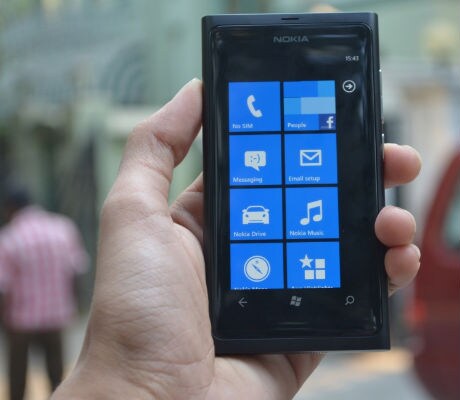
How the mighty have fallen. Seriously, how the mighty have fallen! Nokia, once a dominant indefatigable force in the phone market, has now been relegated to the sidelines of both the budget and the high end segments. Even as the iPhone eata away Nokia's share in the high-end segment, Android devices are cannibalizing into its once undisputed dominance of all verticals if the market.
With MeeGo way behind schedule, Nokia's newly minted CEO Stephen Elop pulled the plug on the project in February and locked a special agreement with Microsoft, turning Windows Phone into the Finnish giant's premier smartphone platform. The Lumia 800 is a synthesis of this marriage.
Design
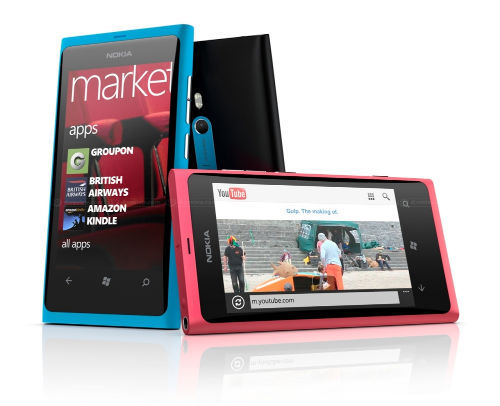
Words cannot describe how beautiful looking the Lumia 800 is. However, we can't help but make comparisons with the erstwhile Nokia N9, which basically shares the same chassis with the Lumia 800, dropping the button-less display for the Windows Phone capacitive buttons and adding a two stage camera shutter button.
Design wise, we will not say the Lumia 800 trumps the iPhone 4 because even a year later the iPhone 4 is stunning to look at. Where the Lumia 800 scores over the iPhone 4S is definitely durability. It is a well-known fact that the iPhone 4S is pretty fragile thanks to its glass exterior, but one will face no such problems with the Nokia Lumia 800. With its injection moulded unibody polycarbonate exoskeleton, the Lumia 800, like its twin the N9, is not only a showstopper but also an immovable rock.
Its curved glass clear black AMOLED display is a work of art and looks like the famous crystal crafted in Prague. The display floats on top of the body giving us an illusion of water on top of a surface.
At 3.7 inches, the display on the Lumia 800 is a tad smaller than the N9 and features a slightly lower WVGA resolution of 800x480 because of the hardware restriction enforced on Windows Phone Mango. This is also the reason for the smaller display as Nokia had to accommodate for the Windows Phone capacitive touch buttons and could not retain the button-less snazziness of the N9.
What we really liked about this particular design was the fact that Nokia does not even attempt to make the device an anorexic piece of plastic. At 12.1 mm, the Lumia 800 is chunky, as was the N9. Compare this to the Motorola Droid Razr, which is the thinnest phone at a meagre 7.1mm.
However, the fact is that Nokia was not gunning for size zero, instead they were aiming for a level of sophistication and ergonomic comfort that 99% of the planet's population would appreciate and that's exactly what this stunning industrial design delivers.
It will not be an overstatement if we say the Lumia 800 is a benchmark in terms of industrial design. But then again the N9 pips it by a smidgen because button-less was the original vision. The addition of Windows Phone buttons is just unnatural, no matter how much Nokia drives home their theory of the Lumia 800 being a refinement of the N9 design. It's not!
Other features of the industrial design are precisely milled speaker holes and magnetic lock doors for the micro-USB and micro-sim ports on the top and bottom ends of the device.
Initially, when we were playing around with the device, we had a bone to pick with these doors as they got stuck and we struggled to unlock them. This happened due to a strange design decision taken by Nokia where the micro-sim port would only reveal itself if the micro-USB door was open. However, it didn't take us long to get used to this eccentricity of the device.
Apart from these design niceties, the standard volume rockers and the power button is placed on the right hand side alongside an additional two stage camera shutter button, which was prominently absent in the N9.
Due to Windows Phone Mango not supporting native video chat, Nokia dropped the front facing camera. We didn't miss it because we consider it a fairly useless functionality given the state of 3G in the Indian market. That said, one would have liked it nonetheless and its absence will definitely come back to haunt Nokia internationally.
On the whole, we were very impressed with Nokia's industrial design and definitely this will be now the benchmark by which all Windows Phone devices are judged.
Display
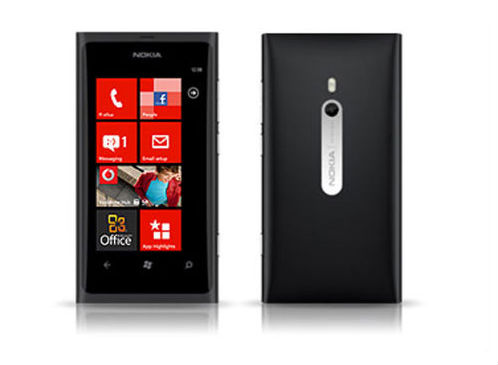
Nokia adopts their Clear Black AMOLED technology for the Lumia 800's 3.7-inch display. It is of the same type as on the N9, with the only variance being in the screen size and resolution. As mentioned above due to Windows Phone hardware cap, Nokia could only implement a WVGA 800x480 panel, but nonetheless it is a stunning panel.
The live tile based Metro UI came to life on this panel with deep blacks and superlative viewing angles. Obviously, it is not in the league of Apple's retina IPS panel or Samsung's SUPER AMOLED HD panel on the Galaxy Note but it is immensely satisfying.
Camera Quality
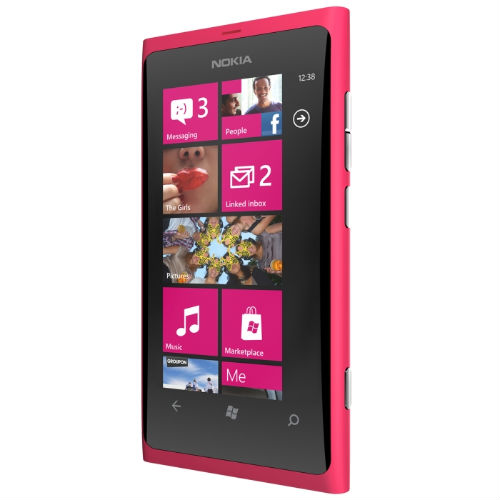
Nokia is one company which has always produced stunning camera phones. Nokia's N8, last year's flagship, was lambasted from all quarters but the one thing it had going for it was its 12-megapixel camera. It was so good that till date its camera is considered the best ever in a mobile phone.
The Lumia boasts of all standard camera jargons, such as an f/2.2 aperture, high performance optics courtesy Carl Zeiss and zero shutter lag, but let's get real - the 8 megapixel camera is no N8. Yes, it's a very good camera phone but it's not the best one in town by a long shot. Even the iPhone 4S boasts of a superior camera. Nevertheless, in the Windows Phone ecosystem the Lumia 800 is the king of camera phones.
On the video front the Lumia shoots crisp 720p HD video, but falls short in low light conditions. 1080p video is not supported by the single core chipset powering the device but since Windows Phone cannot support dual core chips, it's an issue more related to the software platform rather than Nokia's hardware chops.
OS and Interface
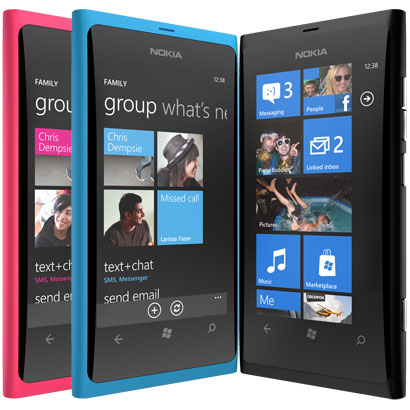
What really differentiates the Lumia 800 from the orphaned N9 is the software running under the hood. No MeeGo out here, Nokia welcomes you to the world of Metro!
When the Nokia-Microsoft deal was announced, a special differentiated Windows Phone experience was touted by both the companies. However we witnessed no such differentiation in the Lumia 800 as the device donned a pretty plane-Jane Windows Phone Mango experience barring a handful of Nokia apps designed for Windows Phone.
Windows Phone on its own is a fantastic operating system but we were left wanting more, especially after what we had seen with the MeeGo powered N9.
Don't get us wrong - Windows Phone works absolutely perfectly if not a tad smoother than on other devices, but the experience does not give the consumer a compelling reason to opt for the Lumia 800. More than this, one could not help but recall the N9 as the curved glass display was infact designed for its unique swiping interface. Unfortunately, here Windows Phone is not able to utilize the design subtleties of the curved glass display, which translates to sheer sadness.
While there is definitely a sense of disappointment with the underwhelming nature of Windows Phone experience on the Lumia 800, there is not even a shadow of doubt that the Metro UI blends well with the hardware especially the injection moulded plastic chassis and we can surely expect a solid differentiated experience on future Nokia devices when we have Windows Phone Tango and Apollo out in the mix..[Conti. reading]
With MeeGo way behind schedule, Nokia's newly minted CEO Stephen Elop pulled the plug on the project in February and locked a special agreement with Microsoft, turning Windows Phone into the Finnish giant's premier smartphone platform. The Lumia 800 is a synthesis of this marriage.
Design

Words cannot describe how beautiful looking the Lumia 800 is. However, we can't help but make comparisons with the erstwhile Nokia N9, which basically shares the same chassis with the Lumia 800, dropping the button-less display for the Windows Phone capacitive buttons and adding a two stage camera shutter button.
Its curved glass clear black AMOLED display is a work of art and looks like the famous crystal crafted in Prague. The display floats on top of the body giving us an illusion of water on top of a surface.
At 3.7 inches, the display on the Lumia 800 is a tad smaller than the N9 and features a slightly lower WVGA resolution of 800x480 because of the hardware restriction enforced on Windows Phone Mango. This is also the reason for the smaller display as Nokia had to accommodate for the Windows Phone capacitive touch buttons and could not retain the button-less snazziness of the N9.
What we really liked about this particular design was the fact that Nokia does not even attempt to make the device an anorexic piece of plastic. At 12.1 mm, the Lumia 800 is chunky, as was the N9. Compare this to the Motorola Droid Razr, which is the thinnest phone at a meagre 7.1mm.
However, the fact is that Nokia was not gunning for size zero, instead they were aiming for a level of sophistication and ergonomic comfort that 99% of the planet's population would appreciate and that's exactly what this stunning industrial design delivers.
It will not be an overstatement if we say the Lumia 800 is a benchmark in terms of industrial design. But then again the N9 pips it by a smidgen because button-less was the original vision. The addition of Windows Phone buttons is just unnatural, no matter how much Nokia drives home their theory of the Lumia 800 being a refinement of the N9 design. It's not!
Initially, when we were playing around with the device, we had a bone to pick with these doors as they got stuck and we struggled to unlock them. This happened due to a strange design decision taken by Nokia where the micro-sim port would only reveal itself if the micro-USB door was open. However, it didn't take us long to get used to this eccentricity of the device.
Apart from these design niceties, the standard volume rockers and the power button is placed on the right hand side alongside an additional two stage camera shutter button, which was prominently absent in the N9.
Due to Windows Phone Mango not supporting native video chat, Nokia dropped the front facing camera. We didn't miss it because we consider it a fairly useless functionality given the state of 3G in the Indian market. That said, one would have liked it nonetheless and its absence will definitely come back to haunt Nokia internationally.
On the whole, we were very impressed with Nokia's industrial design and definitely this will be now the benchmark by which all Windows Phone devices are judged.
Display

Nokia adopts their Clear Black AMOLED technology for the Lumia 800's 3.7-inch display. It is of the same type as on the N9, with the only variance being in the screen size and resolution. As mentioned above due to Windows Phone hardware cap, Nokia could only implement a WVGA 800x480 panel, but nonetheless it is a stunning panel.
The live tile based Metro UI came to life on this panel with deep blacks and superlative viewing angles. Obviously, it is not in the league of Apple's retina IPS panel or Samsung's SUPER AMOLED HD panel on the Galaxy Note but it is immensely satisfying.
Camera Quality

Nokia is one company which has always produced stunning camera phones. Nokia's N8, last year's flagship, was lambasted from all quarters but the one thing it had going for it was its 12-megapixel camera. It was so good that till date its camera is considered the best ever in a mobile phone.
The Lumia boasts of all standard camera jargons, such as an f/2.2 aperture, high performance optics courtesy Carl Zeiss and zero shutter lag, but let's get real - the 8 megapixel camera is no N8. Yes, it's a very good camera phone but it's not the best one in town by a long shot. Even the iPhone 4S boasts of a superior camera. Nevertheless, in the Windows Phone ecosystem the Lumia 800 is the king of camera phones.
On the video front the Lumia shoots crisp 720p HD video, but falls short in low light conditions. 1080p video is not supported by the single core chipset powering the device but since Windows Phone cannot support dual core chips, it's an issue more related to the software platform rather than Nokia's hardware chops.
OS and Interface

What really differentiates the Lumia 800 from the orphaned N9 is the software running under the hood. No MeeGo out here, Nokia welcomes you to the world of Metro!
When the Nokia-Microsoft deal was announced, a special differentiated Windows Phone experience was touted by both the companies. However we witnessed no such differentiation in the Lumia 800 as the device donned a pretty plane-Jane Windows Phone Mango experience barring a handful of Nokia apps designed for Windows Phone.
Windows Phone on its own is a fantastic operating system but we were left wanting more, especially after what we had seen with the MeeGo powered N9.
Don't get us wrong - Windows Phone works absolutely perfectly if not a tad smoother than on other devices, but the experience does not give the consumer a compelling reason to opt for the Lumia 800. More than this, one could not help but recall the N9 as the curved glass display was infact designed for its unique swiping interface. Unfortunately, here Windows Phone is not able to utilize the design subtleties of the curved glass display, which translates to sheer sadness.
While there is definitely a sense of disappointment with the underwhelming nature of Windows Phone experience on the Lumia 800, there is not even a shadow of doubt that the Metro UI blends well with the hardware especially the injection moulded plastic chassis and we can surely expect a solid differentiated experience on future Nokia devices when we have Windows Phone Tango and Apollo out in the mix..[Conti. reading]
Source: NDTV







Post a Comment